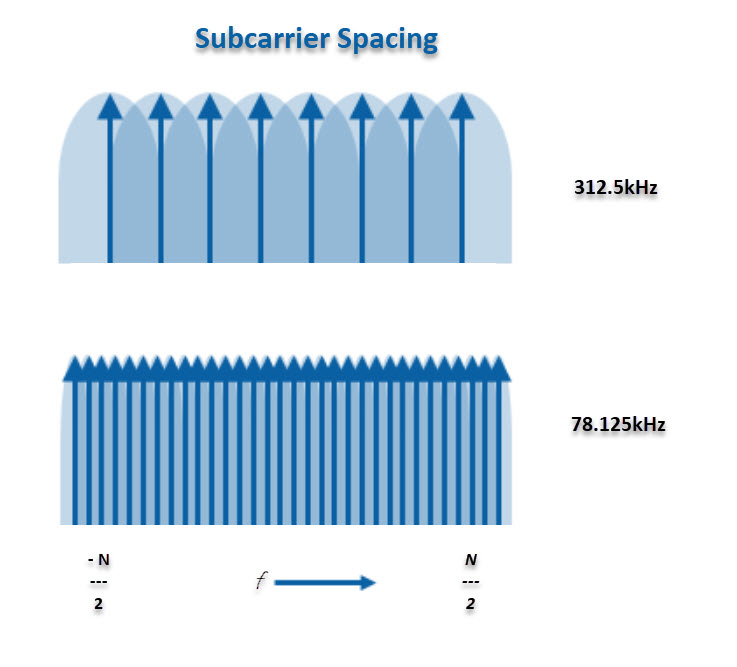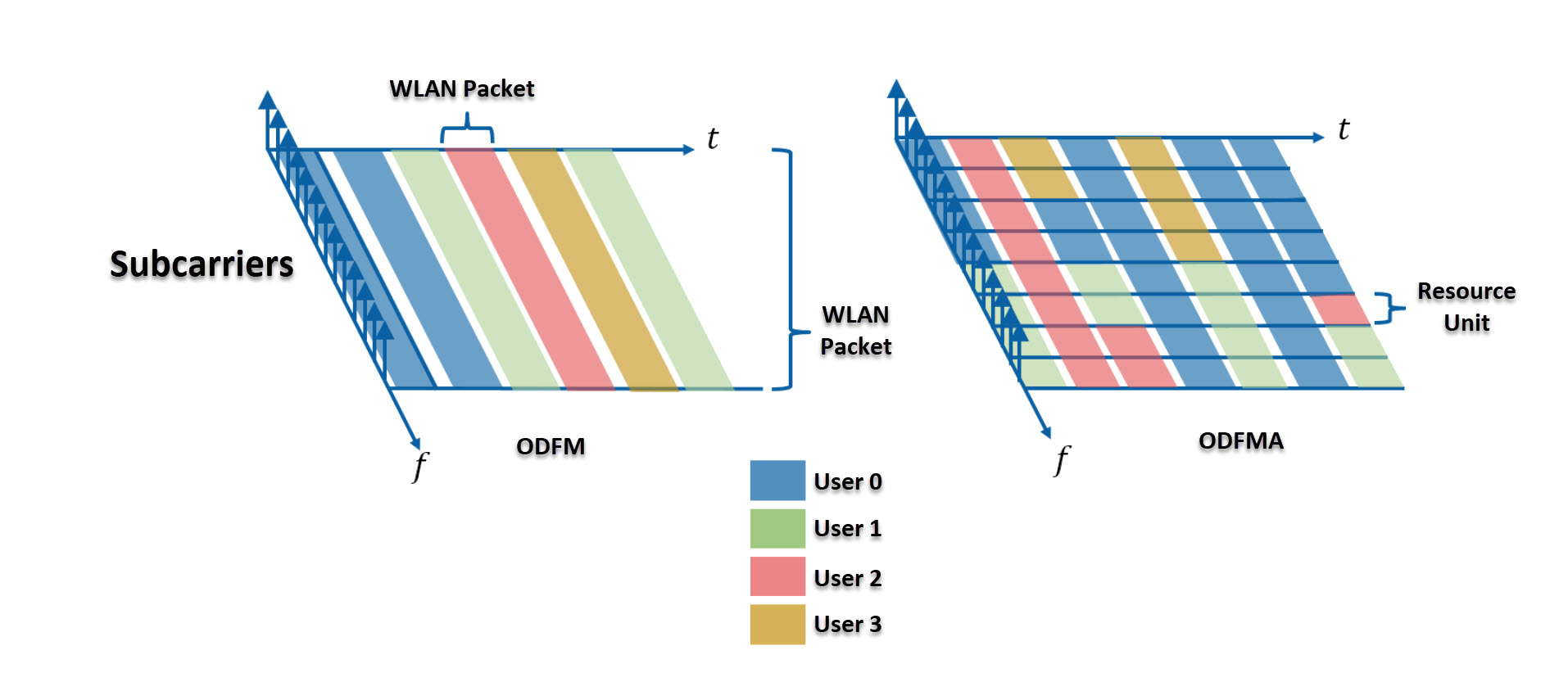The first widespread home electrical appliance was the toaster, and 90% of homes today still have one.[i] Today, wireless connectivity to the internet is as ubiquitous as electricity was a hundred years ago. Smartphones, tablets, wearables, laptops, televisions, Nest thermostats, Alexa, Google Home, Ring video doorbell sensors, surveillance cameras, door locks, smart lighting, and anything else that qualifies as part of the Internet of Things (IoT) use Wi-Fi. Internet service via Wi-Fi is the new utility and serves an abundance of bandwidth-hungry applications. Older homes have fewer electrical outlets, and too many appliances can blow a fuse—reminiscent of our present-day bandwidth issues.
The development of the new 6th generation wireless standard, 802.11ax, is also called High-Efficiency Wireless (HEW). Wi-Fi 6, or 802.11ax, aspires to quadruple the average throughput per user over the latest 802.11ac specification. Wi-Fi 6 will expand wireless connectivity to provide a consistent and reliable data stream, or average throughput, for every user regardless of whether environments are jam-packed with users. Also, Augmented and Virtual reality, 4K video, and 8K video involve more substantial amounts of streaming data than earlier technologies expected.
Blowing breakers is a thing of the past, whereas high congestion, slow data streams, and narrow capacity are a thing of the present that will continue to cause issues for Wi-Fi-dependent applications. The first Wi-Fi standard’s (802.11b) top link speed was 11 Mbps. Released in 1999, 802.11b was slower than a wired connection at the time. The IEEE 802.11ac standard was released in 2013 and finally offered wireless connectivity at a blazing (albeit theoretical) 7 Gbps.
However, now users often experience frustratingly slow data traffic in spite of faster 802.11ac connections, which is like driving a Hennessey Venom F5 (which can top 300 MPH) on congested L.A. highways at 10 MPH. And wireless signal congestion will only get worse since the average household has about ten devices connected to the Internet today and is forecasted at 50 by 2022.[ii] Indeed, few devices in homes today are connected by ethernet cable; almost everything uses a wireless connection.
However, IEEE 802.11ax is supposed to fix the congestion problem. Planned for formal release in 2019, manufacturers have already jumped the starting gun and released 802.11ax routers (which will need firmware updates if the standards change upon official release).
The 802.11ax standard enhances performance in both the 2.4 GHz and 5.0 GHz spectrum bands, theoretically delivering several gigabits per second of throughput to many more devices, all at once, over a single channel. Some of the key vehicles by which IEEE 802.11ax betters 802.11ac include multi-user Multiple Input Multiple Output (MU-MIMO), multiple access modulation, multi-frequency accommodation, Basic Service Set (BSS) coloring, and Target Wake Time (TWT). Many 802.11ax features take a page from modern cellular communications.
Wi-Fi 6, or IEEE 802.11ax, promises a maximum theoretical speed of about 10Gbps, which is 38 percent higher than what you get from 802.11ac. However, although IEEE 802.11ax provides an inconsequential increase in speed, it will handle much more traffic, providing higher throughput. In an analogy to L.A. traffic, 802.11ax, were it a highway, would have 24 lanes on the highway over the present-day six lanes.
IEEE 802.11ax depends on a patchwork of several technologies, for instance, beamforming, MU-MIMO, a multiple access higher-order modulation arrangement, more effective scheduling amongst devices, and a few others.
Key features and applications
The new IEEE 802.11ax/Wi-Fi 6/High Efficiency Wireless standard:
- is backwards compatible with older versions 802.11a/b/g/n/ac
- increases by 4X the average throughput per user in highly populated environments such as stadiums, airports, festivals, and train stations.
- improves traffic flow and channel access
- improves power management, aiding devices in longer battery life
- includes multi-user operations for downlinks and uplinks by using Orthogonal Frequency Division Multiple Access (OFDMA) technology and MU-MIMO
- Four times greater sized OFDM Fast Fourier Transforms (FFTs), and a 4X longer symbol time, leading to improved robustness and better performance in multipath fading as well outside.

Multiple access modulation
A significant improvement starting with 802.11ax borrows 4G cellular technology that utilizes multiplexing to fit more users in the bandwidth of the same channel. Orthogonal Frequency Division Multiple Access (OFDMA) modulation is an improvement and an enhanced version of Orthogonal Frequency-Division Multiplexing (OFDM). OFDM was utilized in 802.11ac. OFDMA increases both efficiency and capacity by permitting some devices to inhabit the same channel bandwidth, which helps to sustain several data streams.
Based on the traffic needs of multiple users, the 802.11ax Access Point (AP) determines how to allocate a channel and assigns all available resource units. The AP might allocate the entire channel to just one user just as 802.11ac does it, or the 802.11ax access point may partition the channel to provide resources to multiple users simultaneously.[iii]

Multi-user MIMO and beamforming
Multiple Input Multiple Output (MIMO) technology is already an important Wi-Fi technology, beginning with 802.11n. The 802.11ax standard borrows MIMO from 802.11ac and uses beamforming techniques. The access point can aim simultaneous beams at different users, with each beam holding specific packets for the user it’s focussed on. The 802.11ac standard can support sending up to four multi-user MIMO signals simultaneously, whereas the 802.11ax increases multi-user MIMO transmissions to eight.
BSS coloring: spatial re-use via color codes
A Basic Service Set (BSS) is a set of wireless clients associated with the same access point. In other words, an access point and devices that are connected to Wi-Fi form a BSS. New in 802.11ax is the ability to remedy the inefficient reuse of channels. Earlier 802.11 protocol used Carrier Sense Multiple Access (CSMA). CSMA avoids collisions by only transmitting if it senses that the channel isn’t being used. However, in very dense usage cases, CSMA creates interference between users. CSMA does not benefit user density experienced in airports, stadiums, and train stations.
Therefore, 802.11ax improves system-level performance as well as the best use of spectrum resources in densely populated areas with a spatial reuse technique. BSS coloring inserts an identity in a transmitted Wi-Fi signal. Receiving devices see this “colored” signal and know which BSS is sending it, the strength of its signal, and a new logic sequence to optimize the process of deciding when to transmit it and when not.
BSS coloring is in the 802.11ax standard, usable by both access point and client devices, such that the new 802.11 standard can effectively diminish co-channel interference.
Saving battery with improved TWT feature
IEEE 802.11ax has a Target Wake Time (TWT) which improves the battery life of mobile devices. TWT ensures (via precise synchronization) that devices will use full power only when communicating with the access point is necessary.
IEEE 802.11ax reflects a complicated evolution of wireless communication along a growing standard based on 802.11. IEEE 802.11ax will provide 4K/8K streaming video to several users simultaneously, significant power savings, and an improved means for AR/VR applications to work better in real-time (e.g., reducing lag between physical actions and a headset’s response, etc.)
It will be a breath of relief to finally have fast, dependable wireless connectivity for everyone in the house for both high definition multi-player gaming and streaming video in one room, 4K streaming movies in two or three other rooms, and twenty or so always-connected “smart home” devices. Perhaps the next problem to solve will be widening the bandwidth and lowering cost for internet pipes serving whole neighborhoods.
To learn more about 802.11ax, look at some of the following resources:
CISCON White Paper on 802.11ax (a PDF), and National Instruments’ Introduction to 802.11ax High-Efficiency Wireless.
[i] https://newatlas.com/go/4824/
[ii] https://cio.economictimes.indiatimes.com/news/internet-of-things/households-have-10-connected-devices-now-will-rise-to-50-by-2020/53765773
[iii] http://www.ni.com/white-paper/53150/en/#toc1





Impressive!Thanks for the post